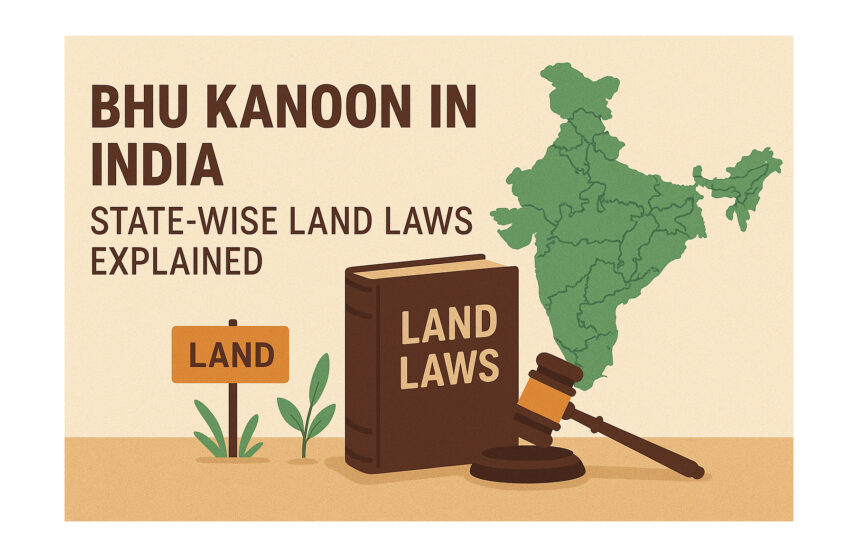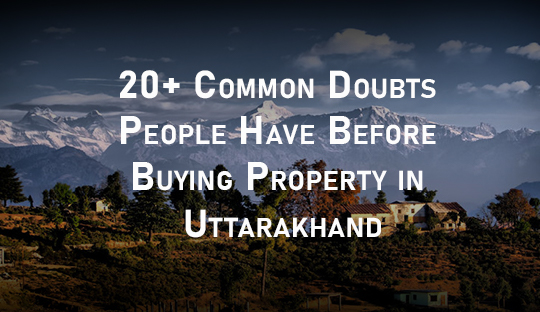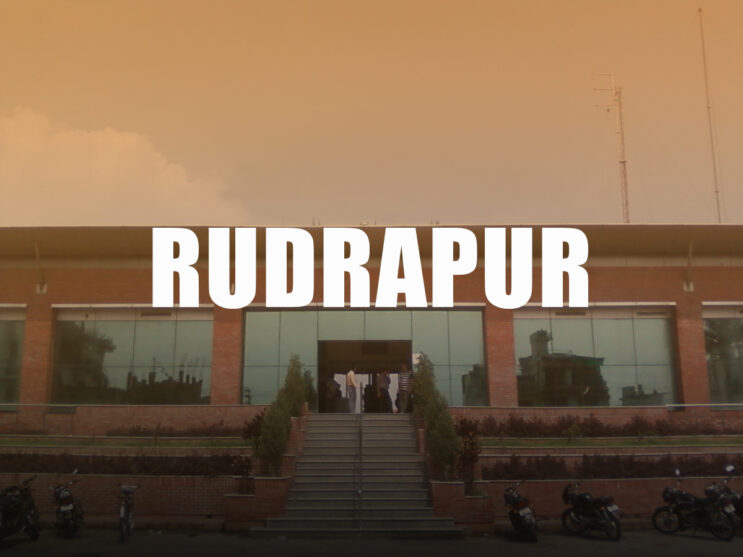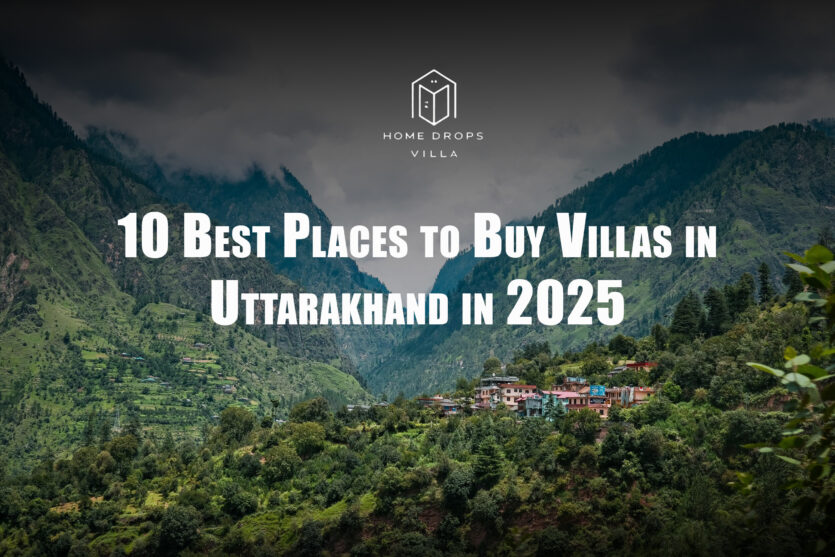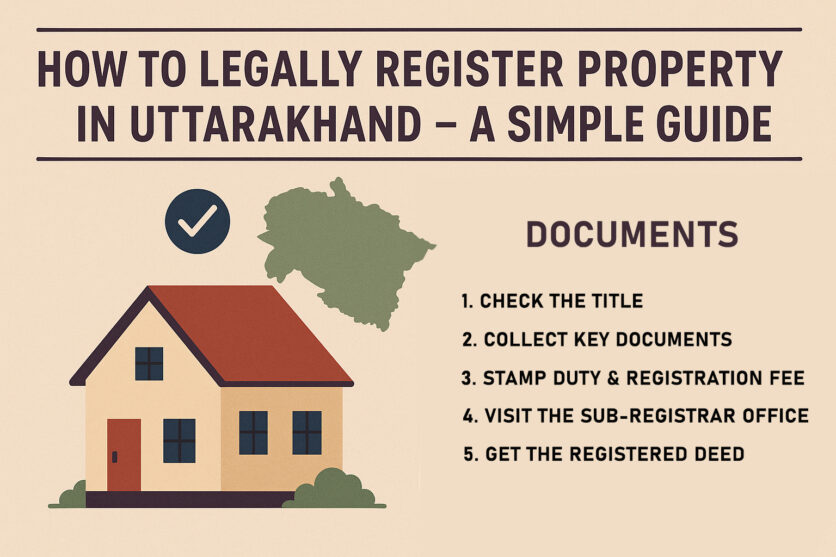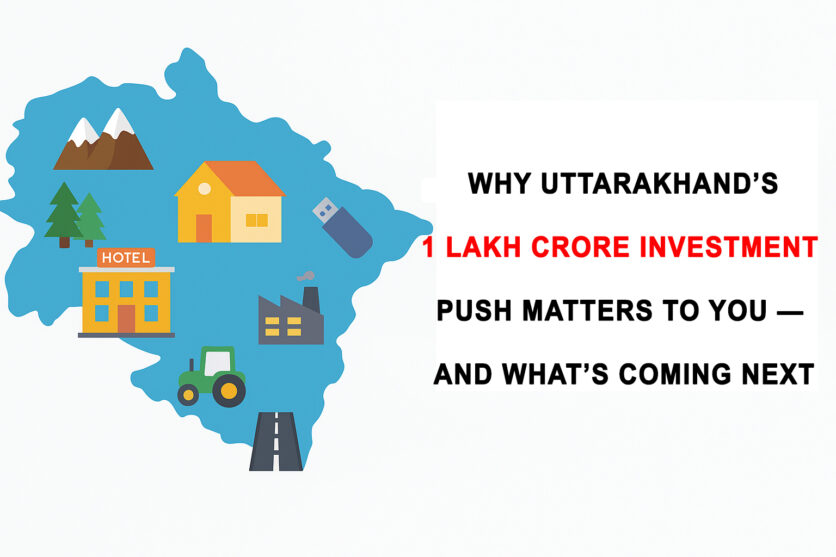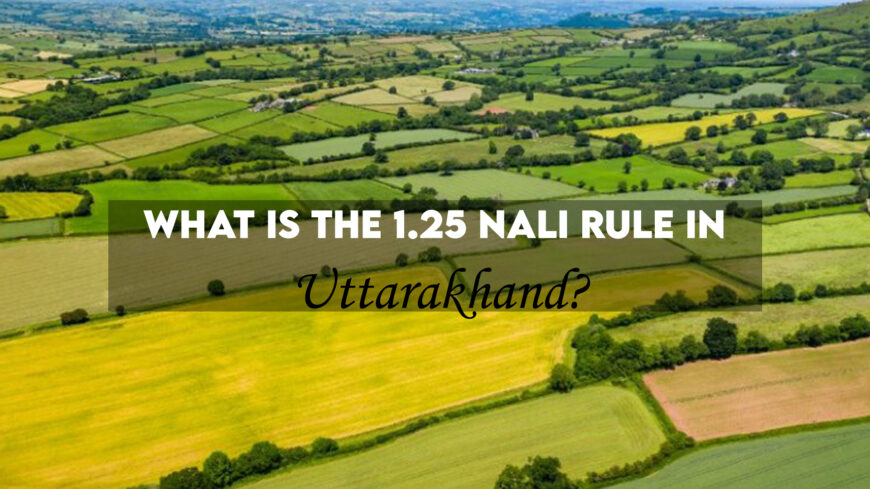Bhu Kanoon in India: State-Wise Land Laws Explained
Introduction Land is not just property in India—it represents livelihood, identity, and heritage. To safeguard these aspects, every state has framed its own set of land laws, commonly known as Bhu Kanoon. Since land is a State subject under the Indian Constitution, each state decides how land can be owned, transferred, and used. Alongside central laws such as RERA (2016), the Transfer of Property Act (1882), and the Registration Act (1908), states have unique regulations that reflect their geography, economy, and local needs. Why Bhu Kanoon Exists To protect farmers, tribals, and locals from exploitation or displacement. To prevent land concentration in the hands of a few landlords or land mafia. To regulate tenancy and urban housing. To balance development with ecology, especially in hill and tribal states. Central Laws That Apply Nationwide While states create their own rules, some major central laws provide the framework: RERA (2016) – Brings transparency in real estate projects. Transfer of Property Act (1882) – Governs sale, lease, mortgage of property. Registration Act (1908) – Ensures property transactions are legally recorded. Benami Transactions (Prohibition) Act (1988, amended 2016) – Prevents illegal ownership. Land Acquisition, Rehabilitation & Resettlement Act (2013) – Ensures fair compensation for land acquired by government. State-Wise Snapshots of Bhu Kanoon Here’s a quick overview of land laws across India’s 28 states. Each state has its own specific acts and rules, shaped by its unique socio-economic realities: Andhra Pradesh – Land Reforms (Ceiling on Agricultural Holdings) Act (1973) limits holdings; tenancy rules protect cultivators. Arunachal Pradesh – Customary tribal laws prevent outsiders from owning land. Assam – Land & Revenue Regulation (1886) and Tenancy Act (1971) govern tenancy and tribal protections. Bihar – Bihar Tenancy Act (1885) and Land Reforms Act safeguard farmers; ceiling limits apply. Chhattisgarh – Similar to MP; strong tribal protections prevent exploitation. Goa – Goa Land Revenue Code (1968) and Tenancy Act regulate agricultural holdings and tenancy rights. Gujarat – Bombay Tenancy & Agricultural Lands Act applies; restrictions on transfer of tribal land. Himachal Pradesh – HP Tenancy and Land Reforms Act (1972) restricts outsiders from buying agricultural land without government approval. Jammu & Kashmir – Earlier outsiders couldn’t buy land; post-2019 reforms allow non-residents limited rights to purchase non-agricultural land. Jharkhand – Chotanagpur Tenancy (CNT) Act (1908) and Santhal Pargana Tenancy (SPT) Act (1949) protect tribal land from being sold to outsiders. Karnataka – Land Reforms Act (1961) and Rent Act (1999) govern tenancy; agricultural land restricted for non-farmers. Kerala – Land Reforms Act (1963) imposed ceilings; Paddy Land and Wetland Act (2008) prevents misuse of agricultural land. Madhya Pradesh – MP Land Revenue Code (1959) governs ownership and ceiling; tenancy protections for small farmers. Maharashtra – Maharashtra Ownership Flats Act (1963), Rent Control Act (1999), and MahaRERA protect buyers; advanced urban housing regulation. Manipur – Land Revenue and Reforms Act (1960) applies; tribal lands have additional protections. Meghalaya – Customary tribal laws dominate; outsiders restricted under Meghalaya Transfer of Land Regulation Act (1971). Mizoram – Land Revenue Act (2013) regulates land use, but most land is under customary ownership. Nagaland – Governed by Article 371A; land belongs to communities and tribes. Odisha – Odisha Land Reforms Act (1960) and land consolidation laws regulate holdings and redistribution. Punjab & Haryana – Punjab Land Revenue Act and tenancy laws govern agricultural land; strong urban development acts regulate housing. Rajasthan – Rajasthan Tenancy Act (1955) and Urban Improvement Act govern tenancy, ceilings, and planned development. Sikkim – Revenue Order No.1 (1917) restricts sale of land to non-Sikkimese. Tamil Nadu – Buildings (Lease and Rent Control) Act (1960) and Land Ceiling Act regulate tenancy and urban property. Telangana – Telangana Tenancy and Agricultural Lands Act (1950) and Dharani digital portal regulate land records. Tripura – Land Revenue and Reforms Act (1960) regulates holdings. Uttarakhand – Outsiders may purchase up to 2,500 sq.m. for residential purposes; protests demand stricter Bhu Kanoon. Uttar Pradesh – UP Zamindari Abolition and Land Reforms Act (1950) regulates agricultural holdings; UP-RERA ensures real estate transparency. West Bengal – Land Reforms Act (1955) and Premises Tenancy Act govern tenancy and agricultural land ceilings. Recent Updates 2016 – RERA introduced; states set up their own RERA authorities. 2018 (Uttarakhand) – Outsider land purchase limit increased from 500 sq.m. to 2,500 sq.m. 2019 (J&K) – Article 370 revoked; new land laws allow outsiders limited rights. Ongoing – Digital land record initiatives (e.g., Bhulekh UP, Dharani Telangana, e-Dharti Delhi) improve transparency. Why People Should Care Buyers – Avoid illegal deals by knowing outsider restrictions. Locals – Protect community land from exploitation. Investors – Understand state rules before investing. Policy makers – Balance development with protecting heritage and ecology. Conclusion Bhu Kanoon reflects the unique identity and needs of each Indian state. While central laws ensure a basic framework, state-specific regulations safeguard locals, preserve cultural identity, and balance development with sustainability. For anyone dealing with property—whether buying, selling, or investing—understanding these laws is not optional, it’s essential.
20+ Common Doubts People Have Before Buying Property in Uttarakhand
Uttarakhand, often called Devbhoomi, has become one of the most attractive real estate destinations in India. From peaceful hill stations like Mussoorie and Nainital to developing cities like Dehradun, Haldwani and Rudrapur many people dream of owning a house or land here. But the process is not as straightforward as in other states. Uttarakhand has special land laws to protect its environment and the rights of local residents. Outsiders (non-residents of Uttarakhand) often have many doubts before investing. In this blog, we’ll answer 20+ detailed questions that buyers commonly ask. Legal Doubts 1. Can outsiders buy property in Uttarakhand? Yes, but with restrictions. A non-resident of Uttarakhand can purchase only up to 250 square meters (about 2,690 sq. ft.) of land without special permission. If you want to buy more, you must apply to the District Magistrate (DM office), and approval depends on your purpose (for example, hotel, resort, school, or industry). 2. Can outsiders buy agricultural land? No. Agricultural land is reserved for farmers of Uttarakhand. Outsiders cannot directly purchase it for farming. However: If you want to build a house, you must buy residential land only. For commercial use (like resorts or hotels), you need special government approval for land conversion. 3. Which districts have stricter land laws? Yes, rules are not the same everywhere. In Dehradun, Haridwar, and Udham Singh Nagar, outsiders often buy land because rules are comparatively relaxed and urban demand is high. In hill districts like Chamoli, Pauri Garhwal, Uttarkashi, Rudraprayag, Pithoragarh, Almora, and Champawat, land purchase rules are stricter to protect the fragile Himalayan ecology. Outsiders are generally restricted to small residential plots (up to 250 sq. m.) in these hill districts. 4. Can companies, trusts, or NRIs buy land? Companies/Trusts can buy land for projects (hotels, industries, schools), but they need special government approval. NRIs and OCI cardholders can buy property (flats, residential houses, plots) but not agricultural land. 5. What happens if I want to buy more than 250 sq. m.? You need to apply for permission at the Collector/DM office. You must justify the purpose (like resort, hotel, school, or large housing). Approval is not guaranteed; it is case-by-case. Documentation & Legal Process 6. What documents are required? Sale deed Title deed (ownership proof) Encumbrance certificate (shows no loans/disputes) Mutation records (Khatauni/Khasra) Identity proof (Aadhaar, PAN, Passport) NOC (if applicable, e.g., from society or Gram Sabha) 7. How to check if property is genuine? Verify land records at the Tehsil office. Cross-check ownership in Khatauni (land record). Ensure it is not forest land, Gram Sabha land, or disputed land. Take help from a local lawyer. 8. What is mutation, and why is it important? Mutation means updating the ownership of land in government records after purchase. Without mutation, your name will not appear in official land records, which can cause legal problems later. 9. What are stamp duty and registration charges? Stamp Duty: Around 5–7% of the property value. Registration Charges: Around 1–2%.Women buyers often get lower stamp duty, which reduces overall cost. 10. What is RERA, and why is it important? RERA (Real Estate Regulatory Authority) ensures builders follow rules. Before buying a flat or house from a developer, always check if it is RERA-registered on the official Uttarakhand RERA website. Location-Based Doubts 11. Which are the best places to buy property? Dehradun – city life, good rentals, education hub. Mussoorie & Nainital – popular for holiday homes and resorts. Rishikesh & Haridwar – high demand for spiritual tourism and rentals. Haldwani & Kashipur – emerging as business and residential hubs. 12. Are there areas where I cannot buy property? Yes. Some lands are restricted: Forest land Ceiling land (exceeds land limit laws) Gram Sabha land (community land) Outsiders cannot buy these lands under any circumstance. 13. Is it safe to buy property in hilly areas? It depends. Always check: Landslide zones (avoid steep slopes). Flood-prone areas (avoid near rivers). Road access and water supply. Investment & Financial Doubts 14. Is buying property in Uttarakhand a good investment? Yes. With tourism, infrastructure growth, and rising demand for second homes, property values are appreciating. Locations near Dehradun airport, Rishikesh, and Haldwani are showing strong growth. 15. How much appreciation can I expect? On average, property prices in popular areas like Dehradun, Mussoorie, and Haridwar have seen 8–12% growth per year in the last decade. Tourist rentals also bring good returns. 16. Can I take a home loan for property in Uttarakhand? Yes. Banks and NBFCs offer home loans for residential properties, provided documents are clear and the property is not disputed. 17. What about property tax? Property tax rates vary by municipality, but in most towns, it is between 0.2% and 1% of property value per year. 18. Is rental income good? Yes. Tourist places (Nainital, Mussoorie, Rishikesh) are good for holiday rentals and homestays. Cities (Dehradun, Haldwani) give steady rental income from students and working professionals. Safety & Fraud Concerns 19. What are common property frauds in Uttarakhand? Selling forest land as private land. Misrepresenting Gram Sabha land as saleable. Fake documents or forged sale deeds. 👉 Always verify ownership and consult a lawyer 20. How do I avoid fraud? Check ownership in Khatauni/Khasra. Ensure seller has clear title. Avoid cash-only deals. Buy only from RERA-registered projects. Practical & Environmental Doubts 21. Are landslides a real problem? Yes, in hilly districts. Always check geological survey reports before building in steep areas. 22. Is it safe to buy land near rivers? No, because of flood risk and government restrictions on riverbeds. Always check with the local authority. 23. Do hill houses face water and electricity problems? In main towns, no. But in remote villages, availability of water and electricity can be limited. Always check utilities before buying 24. Can I build a resort or homestay? Yes, but you need approval from the Tourism Department and local authorities. Homestays are a booming business in Uttarakhand. Future Growth 25. What is the future of real estate in Uttarakhand? Rapid growth in tourism, yoga, and wellness sector. Dehradun, Rishikesh, and Haridwar are attracting investors. Demand for second homes and rentals is increasing every year. Final Words Buying property in Uttarakhand is a dream for many. But because of special land laws, district restrictions, and environmental factors, buyers must be extra careful. If you plan to invest: Understand the 250 sq. m. rule for outsiders. Check whether the property is in a restricted district or Gram Sabha land. Verify documents at the Tehsil office. Hire a lawyer to avoid fraud. Done wisely, real estate in Uttarakhand can be both safe and highly rewarding.
Property in Rudrapur
Thinking of investing in property or finding a peaceful home near Rudrapur? It’s a smart move — this region is growing fast, and many now believe Rudrapur is one of Uttarakhand’s brightest spots for real estate. At Homedropsvilla, we want to help you understand what’s happening now, where you should look, and how to pick the right property so you get value + comfort. Which Areas Are Getting Attention From what we’ve seen, these localities are among the most promising: AreaWhy It’s StrongKashipur RoadRapid development, connectivity, both residential and commercial growth.GadarpurSlightly away from noise, greener surroundings, growing infrastructure.Sidcul-adjacent zonesProximity for industry/employment drives demand.Danpur / Transit CampAlready established, with amenities; good for people wanting quick move-in.Outskirts / Plot-developmentsIf you want more land + privacy, these zones are cheaper and improving. Here’s how we make buying property easier and safer: We shortlist only verified plots / villas / lands that have correct legal clearances (layout approval, authority permissions, RERA ideas if applicable). We guide you through budget planning: what costs to expect beyond just land (registration, infrastructure, approvals, taxes). We support site inspections — you can see the road condition, water access, electricity availability. We show you what amenities you get: roads, drainage, parks, security, maybe community halls — things that make life comfortable. What’s Driving the Rudrapur Property Market Industry & JobsThanks to SIDCUL and other industrial developers, Rudrapur is pulling in companies, factories, and associated businesses. That means more housing demand from people moving here for work, and that pushes up demand for both houses & plots near industrial zones. Connectivity & InfrastructureRoads are improving, new residential sectors are being laid out, and utilities are getting better. Locations close to major highways, or near airport routes (such as Pantnagar), are especially in demand. Good water, electricity, internal road access make a big difference. Value for MoneyOne of Rudrapur’s biggest strengths is that you can still find property at relatively affordable rates compared to big cities. You often get more land, better layouts, safer localities, and proximity to nature without paying metro prices. Lifestyle ExpectationsBuyers are no longer only looking for a plot; they want full amenities: gated communities, open green spaces, parks, security, maybe villas with modern designs. The premium finish, good architecture, and planning are becoming key differentiators. Risk & ApprovalsUnfortunately, not everything in Rudrapur is completely above board. Some colonies or plots may not have proper approvals, there are restrictions, or registration issues. Illegal or unapproved colonies have been flagged by local authorities. So legal checks are a must. Tips to Pick the Right Property When you’re hunting for property in Rudrapur, keep this checklist in mind: Legal status & approvals – Confirm land is non-agricultural (if needed), approved by local urban or development authority, permissible layout. Connectivity – How far to main road / highway, markets, schools, hospitals, public transport. Basic services – Water supply, electricity, sewage/drainage, road inside the plot / project. Amenities & quality – Parks, landscaping, gated community, proper street lighting, etc. Resale potential & growth – Look at upcoming infrastructure (roads or utilities), which areas are being developed or are growing. Budget beyond costing – Factor all costs: registration, stamp duty, taxes, interior / construction if building, legal fees etc. Why Now Is a Good Time Many properties are been offered in lower price bands (plots under ₹20–30 lakhs), which gives lower entry point for mid investors / first-time buyers. Industrial expansion + job growth means steady demand. Land availability is still reasonable in outskirts, meaning you might get better space, peace, and views without paying for inner-city premiums. As infrastructure improves, appreciation is likely to be good. Some Caution Avoid buying in illegal / unapproved colonies. Check registry status. Even if land is cheap now, remote plots may lag in basic services, so cost of bringing those services (road, water, electricity) could be high. Monitor future development / zoning plans so your area is not adversely affected by undesirable projects. Homedropsvilla’s Promise to You At Homedropsvilla, we aim not just to sell you land or villas, but to help you make a wise investment and enjoy your home without regrets. Transparency, support, and trust are at the core of what we do. If you’re looking for a property in Rudrapur that checks your boxes — whether it’s privacy, price, location or future growth — we’re happy to show you some options, help with legal checks, and ensure you get the best value.
10 Best Places to Buy Villas in Uttarakhand in 2025
Buying a home in Uttarakhand is not just about owning property—it’s about embracing a lifestyle surrounded by natural beauty, peace, and long-term value. With improved road networks, better tourism infrastructure, and rising demand, Uttarakhand real estate has become one of the most attractive investment destinations in North India. Whether you are searching for a second home in the hills or planning a profitable investment in villas, choosing the right location is key. At Homedropsvilla, we specialize in guiding buyers to the most promising destinations. Here are the 10 best places to buy villas in Uttarakhand in 2025. Dehradun – The Evergreen Choice The capital city of Uttarakhand remains a top hotspot for villa buyers. With premium schools, hospitals, and easy connectivity to Delhi, Dehradun combines modern living with natural surroundings. Popular Areas: Rajpur Road, Vasant Vihar, Mussoorie Road Why Invest: High rental demand, long-term value growth Mussoorie – The Queen of Hills If you dream of waking up to misty mornings, Mussoorie offers breathtaking villas perfect as holiday homes or retreats. Popular Areas: Landour, Mall Road vicinity Why Invest: Premium holiday rentals, ideal for luxury villas Rishikesh – For Spiritual Living & Tourism ROI Known for yoga, adventure, and the Ganga ghats, Rishikesh is a year-round tourist magnet. Villas here can serve both as peaceful homes and high-demand rental properties. Popular Areas: Tapovan, Ganga-facing plots Why Invest: Strong Airbnb and homestay potential Nainital – Lakefront Luxury With its stunning lake and year-round visitors, Nainital continues to be a favorite for holiday homes. A villa near the lake is expensive, but offers unmatched lifestyle and appreciation. Popular Areas: Tallital, Mallital, Bhimtal Why Invest: Evergreen tourist demand, luxury property growth Rudrapur – Affordable & Growing As an industrial and residential hub, Rudrapur is ideal for affordable villas. With rising demand from professionals, this city combines practicality with growth. Why Invest: Budget-friendly villas, improving infrastructure Almora – Serene Second Homes For those seeking peace, Almora’s cultural richness and scenic hills make it ideal for second homes or wellness villas. Why Invest: Low property costs, growing popularity for retreats Haridwar – Spiritual Capital with Steady Growth Haridwar sees massive tourist inflows every year. Villas here can be used as personal retreats or guest accommodations. Why Invest: High rental yield, strong long-term demand Haldwani – Gateway to the Hills Haldwani is rapidly becoming a commercial hub. Villas here are more affordable than Nainital, yet close to the hills. Why Invest: Family-friendly living, rising infrastructure Mukteshwar – Offbeat & Picturesque For those who prefer a quieter, eco-friendly lifestyle, Mukteshwar offers beautiful landscapes perfect for boutique villas. Why Invest: Budget-friendly plots, wellness & homestay potential Roorkee – Education & Connectivity Hub Famous for IIT Roorkee, this city has a strong rental market and excellent connectivity. Villas here are gaining traction among professionals and families. Why Invest: Growing demand, steady returns Final Thoughts – Why Choose Homedropsvilla? Uttarakhand offers something for every type of buyer—whether you want a luxury retreat in Mussoorie, a peaceful villa in Almora, or a practical investment in Rudrapur. At Homedropsvilla, we help you find strategically located, legally verified, and high-return properties in Uttarakhand. With our expertise, buying your dream villa becomes smooth, safe, and rewarding. 👉 Looking to buy a villa in Uttarakhand? Contact Homedropsvilla today for site visits and expert guidance.
How to Legally Register Property in Uttarakhand — A Simple Guide
So, you’ve found a beautiful plot in Uttarakhand — maybe in Bhimtal, Mukteshwar, or near Rishikesh. Great! But before you build that dream cottage, let’s talk about the real paperwork. This guide will take you through the complete registration & documentation process — whether you're an outsider or a local. ✅ Step-by-Step: Property Registration in Uttarakhand Check the Title Make sure the land: Belongs to the seller Is free of disputes or inheritance claims Has a mutation record in the seller’s name Ask for: Khasra, Khatauni, mutation proof, and past registry deed Collect Key Documents You’ll need: Seller’s ID proof (Aadhaar, PAN) Land ownership papers Buyer’s ID proof Two passport-size photos (both parties) Power of attorney (if applicable) NOC from forest or revenue if in restricted zones Stamp Duty & Registration Fee Stamp duty: 4% for women, 5% for men Registration fee: 1% of property value Must be paid before visiting the Sub-Registrar Office 👉 Tip: Check the circle rate — it’s the govt’s minimum valuation.You must register at or above this rate. Visit the Sub-Registrar Office Both buyer and seller must appear in person, with 2 witnesses. You’ll: Submit all papers Sign the sale deed Pay stamp duty + fee Do biometric verification (fingerprints) Get the Registered Deed Within a few days, you’ll receive a registered copy of the sale deed.Now, the land legally belongs to you! Avoid These Mistakes Don’t buy without a title check Never skip the mutation record Don’t rely only on brokers — hire a local legal advisor if unsure Final Thought Whether you’re buying a villa in a gated community or a small plot in the hills — registration is what makes it yours legally. Need help verifying land, calculating stamp duty, or managing paperwork? 👉 Follow HomeDropsVilla for verified listings, due diligence help, and zero-brokerage buying.
Why Uttarakhand’s ₹1 Lakh Crore Investment Push Matters to You — And What’s Coming Next
Rudrapur, Uttarakhand | July 19, 2025 If you’ve ever dreamed of investing in or relocating to Uttarakhand — whether for tourism, business, wellness, or a peaceful lifestyle — now may be the perfect time. Uttarakhand just hit a major milestone: over ₹1 lakh crore worth of investment projects have moved from paper to the ground, thanks to strong leadership, clear policy, and a vision to balance development with spiritual heritage. Here’s everything you need to know about what’s changing — and how it may impact you. From Big Promises to Real Projects: The ₹1 Lakh Crore Shift Back in 2023, Uttarakhand signed MoUs worth ₹3.56 lakh crore at the Global Investors Summit. Many were skeptical. But now? ₹1 lakh crore of that is already in motion, with over 81,000 jobs created and major infrastructure projects underway. Union Home Minister Shri Amit Shah put it clearly: “Signing MoUs is easy. Implementing them is where true governance shows.” What’s Already Under Construction — or Completed During the Uttarakhand Investment Festival 2025, the state inaugurated and laid foundation stones for projects worth ₹1,271 crore, including: Polytechnic campuses in Champawat and Tanakpur A new Homeopathic Medical College in Dehradun Drinking water projects in Tanakpur Women’s hostels and transport terminals in multiple districts Improved housing for police and jail staff These are not just announcements — they are direct investments in health, education, and governance for local communities. Growth Meets Devotion: Uttarakhand’s Unique Path What sets Uttarakhand apart from other states? It’s not just industry and roads — it's spirituality, ecology, and wellness that form the foundation of growth. Here’s where Uttarakhand is focusing next: Ayurveda & Yoga industries Organic farming Natural therapies and wellness tourism These aren't just “traditional sectors” anymore — they're multi-crore opportunities, and Uttarakhand is positioning itself as a global leader in them. Better Roads, Safer Pilgrimages, Stronger Tourism Connectivity is transforming too. Key projects are making the mountains accessible — all while protecting their ecology: Char Dham all-weather roads (near completion) ₹4,000 crore Sonprayag–Kedarnath ropeway ₹2,700 crore Govindghat–Hemkund Sahib ropeway Now, tourists and pilgrims can visit year-round — safely, comfortably, and without damaging the environment. A Message Beyond Politics During the festival, Amit Shah didn’t hold back. He urged political unity for the sake of development, reminding everyone: “When a state progresses, it’s not a political win. It’s a win for the people.” He highlighted how leaders like Atal Bihari Vajpayee supported Uttarakhand’s statehood—and how today, under PM Modi, that vision is being turned into visible change. Looking Ahead: Uttarakhand 2047 the long-term goal? By the time India celebrates 100 years of independence in 2047, Uttarakhand should stand not just as Dev Bhoomi (Land of the Gods), but as: ✅ A wellness capital✅ A thriving economy✅ A sustainable tourism powerhouse✅ A role model for balancing tradition and technology Why This Matters to You Whether you’re a potential investor, a developer, a tourist operator, or simply someone looking for a better life — Uttarakhand is becoming a land of real opportunities. With a foundation built on both faith and forward-thinking, this state is: Creating jobs Improving infrastructure Protecting culture and nature Opening doors to ethical investment Final Thought As Amit Shah said: “No power can stop the development of this land.” And now, with over ₹1 lakh crore worth of real projects already underway, that future isn’t a dream — it’s already begun. Want to stay ahead of Uttarakhand’s development boom? Follow HomeDropsVilla for property updates, investment insights, and verified land listings — with zero brokerage for buyers.
“Can Outsiders Buy Property in Uttarakhand?”
Client (Outsider): I’m from Delhi and I’m looking to buy a property in Uttarakhand. Can someone like me legally buy land or a house there? Agent (Broker): Yes, you can buy property in Uttarakhand, but there are some restrictions, especially on agricultural land. May I ask what type of property you're looking for? Client: I’m looking for a small plot to build a cottage near Nainital or Ranikhet. Agent: Alright. For outsiders, you can buy residential land, but there’s a limit of 250 square meters (around 2700 sq ft) if it's in rural or hilly areas. You cannot buy agricultural land unless you are a resident farmer. Client: Oh, interesting. What if I want a bigger area, say half an acre? Agent: That would require special permission from the District Magistrate (DM). In some planned developments, you can get a villa or cottage that’s already approved within the allowed limit. Client: I see. Are there any hidden legal risks or things to check before buying? Agent: Yes. Always verify: Land title Mutation status Clearance from forest/environment department Zoning (residential vs. restricted) I’ll help with the due diligence for any property you shortlist. Client: That’s helpful. Can you share a few options that are within the legal limit and have proper clearance? Agent: Absolutely! At HomeDropsVilla, we’ve already shortlisted some verified properties that match your needs. You'll find everything — prices, Google map location, size, location for public transportation — all directly on our website. For privacy reasons, ownership documents are shared only during face-to-face meetings with serious buyers. And yes, there’s no brokerage when you buy through us. "Would you prefer Rudrapur, Gadarpur, Khatima, Bhimtal, Nainital, or any other area in Uttarakhand only?"
What is the 1.25 Nali Rule in Uttarakhand?
Understanding the 1.25 Nali Rule in 2025: What Every Buyer Must Know The 1.25 nali rule is one of the most crucial aspects to understand before purchasing land in Uttarakhand, especially for non-residents and investors. This regulation governs how much land an outsider can legally purchase in hill districts of the state. 🔍 What is a Nali? In local land measurement:1 Nali = ~216 sq. meters or 2,325 sq. ft.So, 1.25 Nali = ~270 sq. meters or 2,906 sq. ft. 📜 The Legal Framework of the 1.25 Nali Rule The Uttarakhand Zamindari Abolition and Land Reforms Act restricts outsiders (non-agriculturists and non-permanent residents) from buying large parcels of land in hilly areas. However, under Section 143 and recent government clarifications (updated as of 10 July 2025), they are allowed to purchase up to 1.25 nali of residential land in these regions. 📍 Which Areas Are Affected by the Rule? The 1.25 Nali Rule applies in hill districts, including: Nainital Almora Bageshwar Champawat Chamoli Pithoragarh Rudraprayag Pauri Garhwal Tehri Garhwal Uttarkashi ❌ Exempted Districts: Udham Singh NagarHaridwarIn these two districts, outsiders are allowed to purchase land beyond 1.25 nali, subject to local regulations. 🏠 What Type of Land is Permitted? You can only purchase residential land, not agricultural or forest land. It must be: Converted to residential use Outside restricted zones (eco-sensitive or military) Approved by the district development authority 🛠 Can I Build a House on 1.25 Nali? Yes. While it may seem small, this land size is sufficient to build: A 2–3 BHK villa Cottage with garden/parking Homestay or guest house All construction must follow the building bylaws of the respective district. 🚫 Can Outsiders Circumvent This Rule? No. Trying to buy land via local proxies (benami) or splitting ownerships across family/friends may result in cancellation, fines, or legal action. The government has tightened verification and land mutation procedures to detect such frauds. ✅ How to Safely Buy Land Under 1.25 Nali Rule Check land category on official Bhulekh portal Hire a local legal advisor Avoid verbal or token deals Verify mutation and conversion status Stick to plotted or approved townships 💬 Final Word The 1.25 Nali Rule is a protective policy to preserve the fragile ecosystem and land rights of hill communities. But for genuine buyers and home seekers, it still allows an excellent opportunity to build a peaceful home in the mountains. If you're looking for residential plots that fully comply with this rule, Homedropsvilla offers verified listings, legal guidance, and construction services across all legal zones in Uttarakhand.
Can Outsiders Buy Land in Uttarakhand? A Complete 2025 Guide
Uttarakhand, the "Land of Gods," has emerged as a prime destination for people seeking serene retreats, second homes, or land investments in the hills. While the landscape is rich and inviting, the legal framework for purchasing land, especially by non-residents or outsiders, is often misunderstood.In this blog, we break down the legalities, process, risks, and expert tips for buying land in Uttarakhand as an outsider, updated as per rules effective from 10 July 2025. ✅ What is the Legal Definition of an "Outsider"? In Uttarakhand's land law context, an "outsider" is anyone who is not a permanent resident of the state. This includes Indian citizens from other states and Non-Resident Indians (NRIs). 📜 What Does the Law Say? Under the Uttarakhand Zamindari Abolition and Land Reforms Act, non-agriculturists (outsiders) are prohibited from purchasing agricultural land in the state. However, an exception allows outsiders to purchase a small parcel of residential land in hill regions. Key Rule: The 1.25 Nali CapIn hill districts, outsiders can buy up to 1.25 nali (approx. 2,700 sq. ft.) of land for residential purposes only. In plain districts like Udham Singh Nagar and Haridwar, this restriction does not apply, and outsiders can purchase land more freely, including larger residential or agricultural plots, subject to local zoning and development regulations. Note: 1 nali = approximately 216 sq. meters or 2,325 sq. ft. 📌 What Kind of Land Can Outsiders Buy? Only residential-converted land (not agricultural or forest land). The land must be in a zone approved for residential use by the local revenue or municipal authority. ❌ What You Cannot Buy: Agricultural land (without land use conversion) Forest land Land under Gram Sabha or military restrictions ✅ What You Can Buy: Residential plots within the legal limit Flats or built-up homes Land under approved private layouts with residential status Note: In Udham Singh Nagar and Haridwar, outsiders can explore larger residential or even converted agricultural holdings 🧾 Step-by-Step Process for Outsiders to Buy Land in Uttarakhand Identify residential-converted land Ensure it's in a residential zone Check with Patwari or Tehsildar Verify ownership and land use Ask for registry deed (sale deed), mutation record, and land conversion certificate Hire a local property lawyer Important to verify title, encumbrances, and legality Execute Agreement to Sell A legal agreement that confirms intent and terms Registry and Stamp Duty Payment Pay stamp duty (5-7%) and registration chargesRegister the deed at the Sub-Registrar office Mutation and Possession Mutation ensures your name enters land recordsTake physical possession and fence your plot 📈 Can NRIs Buy Land in Uttarakhand? Yes, NRIs are allowed to buy land within the same limits as Indian citizens. However, they must:Follow the 1.25 nali rule in hill districtsIn Udham Singh Nagar and Haridwar, NRIs can also invest in larger plots subject to general lawsEnsure the transaction complies with FEMA regulationsWork with a local legal representative 💡 Risks to Watch Out For Buying agricultural land assuming it can be converted later Trusting verbal promises from unverified agents Overstepping the land limit unknowingly Not checking mutation and land revenue history Purchasing in eco-sensitive zones without permissions 🧠 Expert Tips from Homedropsvilla Always insist on satellite map, mutation copy, and land use certificate Visit the site physically Record your agreement legally, even if it’s with a known person Use a local lawyer and don’t skip due diligence Focus on areas with proper road access and water supply 🙋 FAQ – Outsiders Buying Land in Uttarakhand Q1: Can I buy multiple plots of 1.25 nali each?No. The limit applies to total landholding in hill regions per individual outsider. Q2: Can I construct a villa after buying?Yes, after plan approval from the local authority. Q3: Is the land freehold or leasehold?Most residential land is freehold but verify before buying. 🔚 Final Thoughts While the charm of Uttarakhand's hills is undeniable, land ownership here requires careful planning and full legal clarity. The rules, especially the exemption for Udham Singh Nagar and Haridwar, provide a viable opportunity for larger investments. By staying within the legal framework and working with trusted real estate professionals like Homedropsvilla, you can enjoy the beauty of the hills without legal worries. Would you like us to assist with verified land plots, legal support, or villa construction? Contact Homedropsvilla today and start your safe and peaceful investment journey in Uttarakhand.
Real Estate in Lalpur
A Growing Investment Hub in Udham Singh Nagar Introduction Lalpur, located in Udham Singh Nagar district, is fast gaining popularity as a real estate hotspot. Situated on the Rudrapur–Kichha Highway and just a few kilometers from Rudrapur city, Lalpur offers excellent connectivity, affordable property prices, and growing infrastructure—making it a prime choice for real estate investors. Key Investment Areas Based on the satellite map and local survey, some of the most promising localities and surrounding regions include: Chandola Homoeopathic Medical College area – suitable for residential plots due to student housing demand. Ram Nagar, Bhamraula, and Maharajpur – showing potential for both agriculture and residential development. Pandari and Chukati – strategically located along the Rudrapur–Bareilly Highway (NH-74), ideal for warehouse setups and roadside dhabas. Kishanpur–Chukati Road – gaining attention for future farmhouse and dairy land investments (e.g., Dhillon Dairy Farm, Kunwar Poultry Farm). Jhagorie Farm and Fair Energy Solutions belt – light industrial activities are giving this zone a gradual boost in land prices. Shree Tulsi Dham Mandir, Sri Golju Temple, and other local temples – improve the lifestyle appeal and settlement comfort for families. These areas are all mapped in the screenshot provided, marking Lalpur’s center and surrounding growth zones. Educational Institutions Bhartiyam International School DEVS THALI VIDYAPEETH Primary School, Pandari Shemford School, Rudrapur (10–15 minutes drive) These schools ensure educational access, making the area suitable for families seeking to settle long-term. Services and Facilities Shree Durga Mata Temple, Gurudwara Singh Sabha Malsi, and Sri Golju Temple – provide spiritual centers and community value. Swimming Pool (near Lalpur) – shows promise for lifestyle development. Metro Hospital (near Rudrapur) – top medical support just minutes away. YES Product Pvt. Ltd., Rudrapur Solvents Ltd., and Aggarwals Foods India – reflect the industrial ecosystem supporting Lalpur’s economy. Hotels and PGs, like Hotel Uday Residency, show an existing demand for short-stay and hospitality services. Conclusion Rudrapur Solvents, Ram Nagar, Malsagirdharpur, and Pandari, it's evident that real estate in and around Lalpur is primed for growth. From educational and spiritual centers to road-facing commercial plots and farmland, Lalpur is a hidden gem for investors. 📍Want to explore verified plots and investment opportunities in Lalpur?👉 Visit Homedropsvilla or reach out to get personalized guidance!

